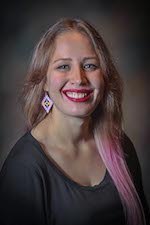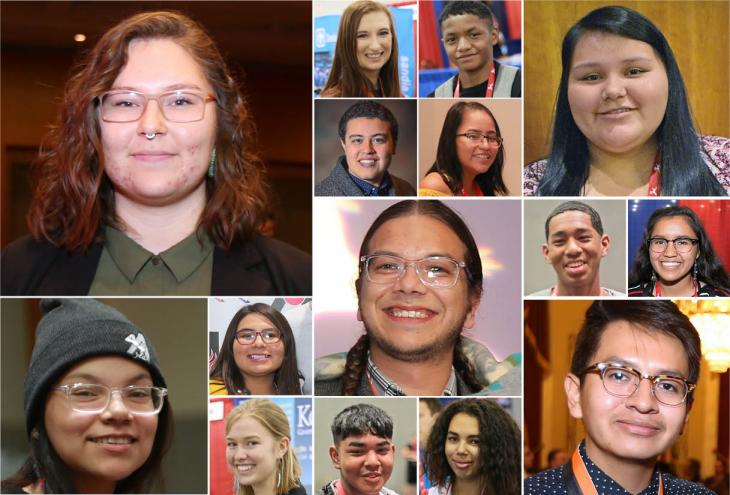The AISES National Conference is known for breaking new ground every year, and 2020 will be no exception. This year’s event is 100 percent virtual and has the potential to bring together more STEM participants than ever before.
For 42 years, the annual National Conference has been the premier event for Indigenous STEM professionals and students from the United States and Canada, and as far away as Alaska and Hawaii. This year’s all-new virtual format will include opening and closing ceremonies, a keynote address, a talking circle, expert-led topical sessions, research presentations, mixers, and Indian Country’s largest College and Career Fair. The three-day agenda features more than 60 live and prerecorded events and numerous opportunities to interact with exhibitors, speakers, sponsors, partners, and conference attendees.
“The digital platform will include everything you would expect at a conference, from the lobby, auditorium, and exhibit halls to networking suites for group chat get-togethers or video one-on-one sessions,” says Katherine Cristiano, senior director of special events at AISES. Cristiano and her team started planning for the possibility of a virtual conference last winter, soon after the first COVID-19 cases were confirmed in the United States. They’ve spent the past six months making the pivot to a virtual conference and customizing an online venue in partnership with the virtual event experts at O’Design.
Here’s what you need to know to make the most out of your 2020 National Conference, which will make its historic launch with pre-event activities on October 14 and the Opening Ceremony on October 15.
Register now. October 5 is the no-exceptions deadline.
Before you shine up your device screen, make sure you take care of job No. 1: register online. “This year, we have a hard-and-fast deadline of October 5,” explains Cristiano. “Because of the lead time required to get participants their credentials and ensure they understand how to access the conference, we won’t be able to make any exceptions.”
Get your IT on.
Your IT setup will be key to your conference participation. Be sure to take care of your online essentials in advance.
• Decide on a device. You’ll be able to attend the conference via any device — tablet, laptop, desktop, or even a mobile phone. “While a laptop or desktop is optimal, participants can use any device with an Internet connection,” says Lani Rich, relationship specialist at O’Design. She points out that while topical group text chats will be available to attendees on all devices, one-on-one video calls can be accessed only on a laptop or desktop.
• Update your Internet browser. Important information: The conference platform is most compatible with the Google Chrome browser. Whatever browser you use, be sure it’s the latest version. “It’s easy to update your browser, but often we see this important step overlooked,” observes Rich. It will help you avoid access issues or unduly slow load times. If you need help, there are useful online resources.
• Check your bandwidth. For a good virtual conference experience, ensure you have enough bandwidth. As a general rule, an Internet connection between five and 10 megabytes per second (Mbps) should be enough. If you Google “test speed,” you’ll get links to sites such as Speedtest and Measurement Lab that will measure your device’s bandwidth.
• Don’t forget your Internet basics. If a session or web page won’t load, you can refresh the page. “Remember to hit the refresh button,” says Rich. “It might seem obvious, but sometimes people get frustrated waiting around rather than refreshing the page.” Not sure how to do this? Get some help online.
Mind your manners.
“The National Conference has always been a ‘safe camp,’ and that remains true for this year’s virtual event,” says Cristiano. She emphasizes that being a safe camp means being a welcoming, inclusive, supportive, and safe environment for all AISES family members regardless of race, color, religion, sexual orientation, or gender expression or identity. It also includes recognizing the AISES Code of Conduct. All conference events and gatherings, including chat conversations, will be moderated.
“As always, the expectation is that everyone remains professional, respectful, and considerate of others,” adds Cristiano. She also highlights some important virtual conference rules:
• Turn off any virtual backgrounds.
• Be respectful of others at all times.
• Do not take screenshots that show other people’s faces!
Come prepared, engage, and follow up.
Registering by October 5 is just the beginning of your conference journey.
• Do your advance work. Be on the lookout for an email from AISES with your event username and password. You will also receive an email with everything you need to know as a participant, including guidelines and protocols.
• Plan ahead. Organize your conference schedule. The virtual platform gives you more options and flexibility, so it’s critical to spend time with the agenda and plan ahead. Set reminders for sessions you don’t want to miss and identify people and organizations you would like to know, such as exhibitors who might be seeking to arrange interviews for jobs or internships. More than 60 prizes will be awarded to people who engage in live participation on the platform.
• Be an active participant. With dozens of sessions and over 150 exhibitors, plan on participating beyond listening. Don’t be afraid to ask questions if there’s a Q&A, and/or submit questions through a session’s chat function. Keep an eye out for ways to expand your network. Pro Tip: To make it easier to connect with speakers, sponsors, and other attendees, “opt in” to share your contact information when you register for the conference.
• Follow up. Another advantage of the virtual platform is that you’ll be able to replay any recorded sessions you missed. This will be an especially handy feature when there’s more than one concurrent session that piques your interest. All recorded sessions will be available to attendees for 30 days after the conference closes. And just as you would after an in-person conference, debrief with fellow attendees and keep in touch with the great new people you meet. Finally: Be sure to complete your post-conference survey!
 On Topic
On Topic
Adrian Riives, Ojibwe (Anishinaabe), is originally from Edmonton, Alberta, Canada. She earned her BS in chemistry from San Jose State University (SJSU) in Silicon Valley, Calif., and is currently pursuing her PhD in chemistry and chemical biology at Rensselaer Polytechnic Institute in Troy, N.Y. Aside from her research, Riives has been active in a number of educational organizations, including the Younger Chemists Committee, the Research Initiative for Scientific Enhancement at SJSU, the Louis Stokes Alliance for Minority Participation, and AISES. Riives, who is currently the elected Junior National Representative and prospective Senior National Representative, decided to run for the role of U.S. National Student Representative because she wants to help students — particularly Indigenous students — find support in their studies and future careers.
How should attendees go about prioritizing sessions to attend at the National Conference?
Every conference, including virtual conferences, will have a program of available sessions. I would first attend the sessions most relevant to my work so that I could not only see what other people are doing within my field, but also network with these people for future collaborations. I would also attend sessions where I could socialize with people within my local region or with other young professionals. I would also recommend attending a session that’s entirely outside your area of discipline. There’s new research being developed on the role of curiosity in aging. While I wouldn’t assert there’s any definitive conclusion, research has found that curiosity is likely a factor in protecting against cognitive decline with aging. So I’d recommend trying to remain curious and learn something novel in life. Life is always exciting.
What can attendees do before the National Conference to gain the most from the experience?
As an introvert, I find that sometimes conferences, while exciting, can be emotionally draining. I mention this because conferences are an excellent place to network, but that takes some time and preparation. I recommend perfecting an “elevator pitch” ahead of time. An elevator pitch is a message that lasts about 30-seconds, supposedly the length of time you spend on an elevator ride. Your pitch should include who you are, what you are studying, what you are seeking in your professional life, and what’s special about you relative to your peers. The online conference will be filled with sponsors, scholarship opportunities, and internship opportunities, with recruiters looking for smart, well-spoken students. Having an elevator pitch will increase your confidence speaking to people and improve your chances of maximizing your networking capabilities.
How can attendees capitalize on the College and Career Fair during the National Conference?
The College and Career Fair will have resume-building centers, which I highly recommend. Here are some questions I’ve asked of colleges: What financial incentives are available at one college or university versus other colleges or universities? Are there other Indigenous students within your program of interest? What is the ranking of the program and some examples of employment of graduates? What are the benefits of attending a private versus a state university? Who will offer the most financial aid? Does a particular university provide internships? What percentage of students gets hired upon graduation and finds long-term employment? What is the graduation rate at this school? When speaking with professional representatives, I’ve asked following: What is the upward mobility and job satisfaction within the company? Would I be working with/under qualified and talented individuals? Am I going to receive adequate mentorship? What kind of benefits does the company offer? What is the competition in this industry?
What are the top three lessons attendees can expect to take away from the National Conference?
1. You are meant to be here as you are a part of our AISES family.
2. You should work hard to present your research and network to make the most of your opportunities.
3. You should have fun! You are bold, you are resilient, you are intelligent, you are capable, you are strong, you are phenomenally Indigenous.














